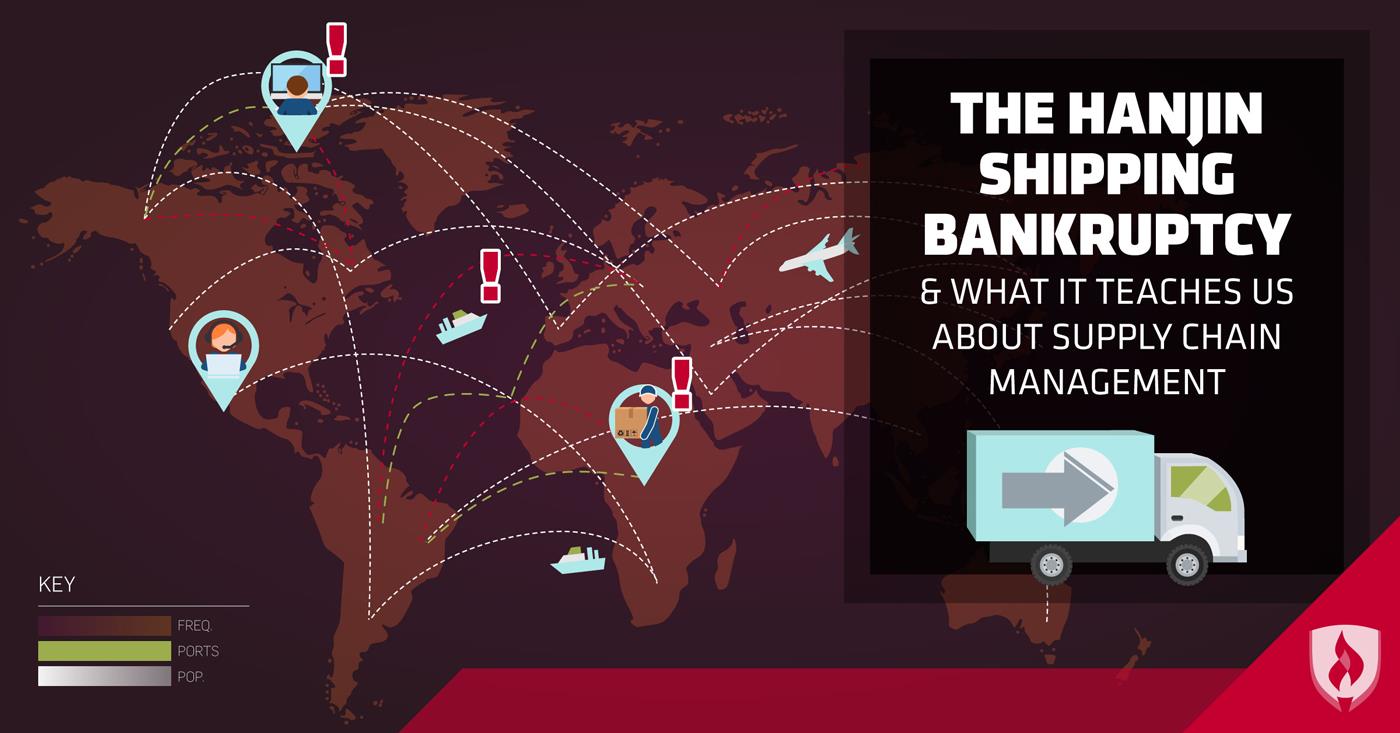The Hanjin Shipping Bankruptcy & What It Teaches Us About Supply Chain Management
By Will Erstad on 02/07/2017

Unless you’ve got your finger on the pulse of supply chain management, the odds are you haven’t heard much of Hanjin Shipping. Despite their relatively low profile, this shipping company made some big waves across the globe with an announced bankruptcy plan in August 2016, leaving several massive freight ships carrying hundreds of cargo containers stranded in an effort to avoid creditors from seizing their cargo.
But this wasn’t just a nightmare for the shipping company itself. The event launched a ripple effect of problems for logisticians and supply chain managers who relied on Hanjin to keep things running smoothly for their employers and clients. While much of these issues are now at least partially resolved, aspiring logistics workers can learn a great deal about the field from the Hanjin Shipping bankruptcy.
We asked supply chain professionals to help identify some of the big-picture takeaways from this situation applying to the overall logistics industry.
5 takeaways
1. It’s called a supply chain for a reason
Like the links of an actual metal chain, every single “link” or step in a supply chain is incredibly important. When one link breaks, the entire chain fails.
Imagine the havoc that follows when an unexpected setback like the Hanjin Shipping bankruptcy occurs. Those ships are an essential link in the supply chains of every business working with them—and suddenly they are stranded. The lesson for future supply chain managers? You need to have your ducks in a row at every stage, but even the best laid plans can take an unexpected turn.
“Disruptions can sometimes cause an entire supply chain to come to a halt, but for many that’s simply not an option,” explains Matt Castle, Vice President of Global Forwarding Products and Services at C.H. Robinson. “The key is to stay on top of what’s happening in the industry and know which alternative means for transportation are available.”
2. Global shipping = global problems
If your supply chain requires the transfer of goods or materials across the globe, it can be impacted by a various number of international concerns. While it’s not exactly a common occurrence for a company that represents about 3.2 percent of global container shipping capacity to declare bankruptcy, there are plenty of other unexpected disruptions that can occur. Natural disasters, political instability and, yes, even pirates, can leave logisticians scrambling for back-up plans.
3. Disruptions spread
When something goes awry within a supply chain, the issues related to the disruption can’t always be contained. Imagine a port being forced to shut down for a week or two due to a massive storm. That results in entire production and delivery schedules needing to be updated as alternative options are secured. These delays can lead to the next step of the process also being delayed, which can then effect the following step, and so on and so forth.
This means that even a seemingly small issue could balloon into a series of larger, more expensive problems. You might prop up the first domino again, but it’s already started a chain reaction through your supply. The goal for logisticians and supply chain professionals is to find solutions that minimize this ripple effect as much as possible.
4. Even your back-up plan needs a back-up plan
Logistics professionals are naturals when it comes to “what if?” situations. They prod for potential weaknesses, develop back-up plans and work on answering the worst case scenario questions that may arise from those plans. As you’ve already learned, there are plenty of things that can go wrong and disrupt a supply chain from seemingly out of nowhere—often the only defense is to plan as many failsafe options as possible.
“Expect the unexpected,” Castle says. “The key is to have a supply chain that is flexible enough to adapt.”
Castle says his organization often shares tips with shippers to help reduce risk. Among them—using interchangeable parts or products, having back-up supplies stored, developing a parallel supply chain, increased data security (and back-ups of that data) and considering all alternative transportation options if necessary. These are just a few tactics that could help minimize the likelihood or impact of a logistical catastrophe.
5. The big picture is key
With so many moving parts and so much area to cover, it can be easy to become caught up in the details of addressing issues on a regional or local level. A truly global supply chain can also present a challenge in determining potential problem areas and how these routes are interconnected.
To help with this, logistics professionals turn to network mapping visualizations or tools like Hi-Viz Supply Chain map technology. This technology allows logisticians to identify where supplies are located across the globe, with overlays of potential problem areas and routes that may be delayed.
No matter the tool or method used, visualization and mapping techniques like these can help logistics professionals anticipate problems and become more proactive in lining up alternative routes or options.
“[These maps] reveal where materials and inventory are located and how customers are served through distribution channels,” Castle explains. “This exposes where the biggest inefficiencies and the greatest risks are.”
A whole world of possibility
Any average Joe probably didn’t hear much about the Hanjin Shipping bankruptcy. But if you asked anyone in the supply chain industry, you’d better believe they’re aware of it. The impact of this seemingly under-the-radar event will continue to send ripples throughout the logistics world. Supply chain disruptions like these can come with some high-pressure problems to solve—but anticipating and avoiding these disruptions is part of the appeal for this line of work.
RELATED ARTICLES:




